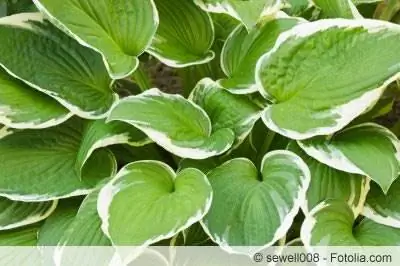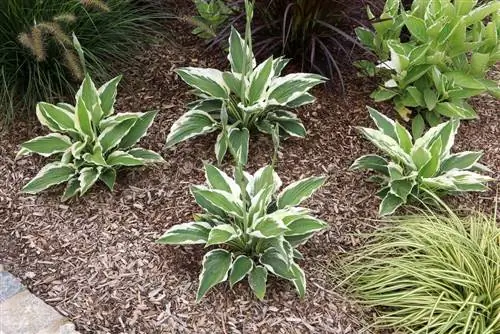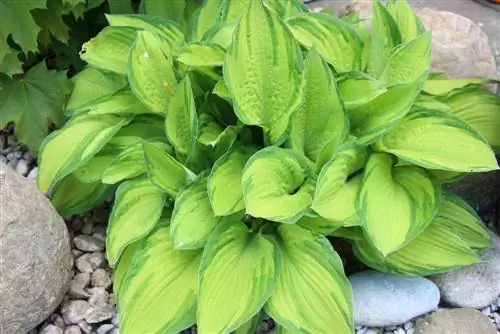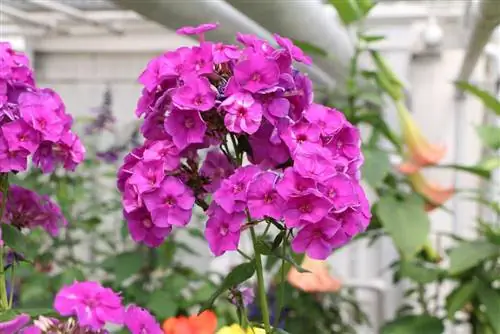- Author admin [email protected].
- Public 2023-12-17 03:39.
- Last modified 2025-01-24 12:45.
Asian hostas have had a steep career in German hobby gardens, from anonymous stopgap to dominant protagonist in creative design. Ideally adapted to shady to semi-shady conditions, the robust, hardy foliage perennials develop into majestic natural beauties over the years.
With a wide selection of more than 4,000 varieties, there is a suitable hosta for every green kingdom. The following lines explain what care and propagation requirements you will encounter with the newly discovered classics.
Profile
- Plant family: Asparagus family (Asparagaceae)
- Genus: Hosta (Hosta)
- located in Japan, China, Korea and Russia
- 45 species with more than 4,000 varieties
- Growth height from 20 to 130 cm
- perennial, herbaceous growing
- hardy and deciduous
- popular foliage plant with racemose inflorescence
- Flowering period from June to August/September
- formed rhizomes or runners
- German title: Sweetheart Lilies
Due to its numerous positive attributes, the Association of German Perennial Gardeners named the hosta perennial of the year in 2009.
Location
As part of successful care, the choice of location for hostas is of utmost importance. Native to the diffuse light of Asian forests and on the cool mountain slopes up to 2.000 meters altitude, sunlight and heat play a minor role. Hosta thrive particularly well under the following conditions:
- shady to semi-shady location
- ideally along a woody edge
- perfectly suited as underplanting for tall shrubs and trees
- Protection from the blazing midday sun must be guaranteed
Knowledgeable breeders have created some Hosta varieties that feel at home in both partially shaded and sunny locations. These hybrids are ideal for cultivation in a container on a sunny terrace.
Soil texture
Another pillar in the exemplary care of hostas is the adequate condition of the soil. The focus is on the following aspects:
- nutrient-rich, humus-rich soil
- loose and well-drained
- like fresh, moist and not too dry
Site conditions and soil conditions are closely related. The shadier the location, the drier the earth can be. Conversely, this means that hostas need sufficient moisture in a sunny spot in order to develop their exuberant beauty.
Watering and fertilizing
The enormous leaf mass of a sweetheart lily signals a high water and nutrient requirement. You can meet these requirements as follows:
- keep the soil constantly moist
- water early in the morning and in the evening on hot summer days
- Do not give the water over the leaves and flowers, but directly to the root area
- fertilize in March and June with compost and horn shavings
- Fertilize hosta in the pot every 4 weeks with worm tea or guano in stick form

The soil stays moist longer under a layer of mulch. In this way, additional watering is reduced, especially in sunny locations, while at the same time annoying weeds are effectively suppressed. Suitable mulching materials include bark mulch, grass clippings and leaves. By the way: To simply automatically water thirsty hostas, clever hobby gardeners fill a used drinks bottle with water, quickly turn it upside down and stick it in the soil next to the plant.
Cutting and overwintering
Although hostas are hardy plants, they unfortunately do not retain their beautiful foliage during the cold season. Wilting sets in after the first frost at the latest, so sooner or later a less than pleasing appearance appears. The above-ground plant parts are cut off close to the ground with a sharp knife and disposed of in the compost. If you don't feel disturbed by the appearance, leave the withered leaves on the sweetheart lilies as winter protection. In this case, cut it off just before the new shoots appear in March or April. In addition, the following measures are recommended for winter storage:
- pile up the root area in the bed with soil, leaves, pine needles or straw
- Place hostas in a pot in front of a protected house wall on wood or Styrofoam
- Cover planters with foil or fleece
- cover the substrate with leaves or fir branches
If there is no snow in winter and it freezes heavily, hostas are threatened by drought stress. Therefore, water the plants on a frost-free day.
Tip:
If withered flowers and leaves are cleaned out regularly over the course of the summer, this measure will motivate your sweetheart lilies to continue sprouting.
Propagate
If you would like to plant more heart lilies in the garden or in containers, you have the choice of two methods of propagation. Which version you choose depends on the goal you want to achieve. Dividing the rootstock produces an identical successor, while sowing can produce a surprising result. How to proceed:
Division
The optimal date for this form of propagation is before the new shoots in spring. In this vegetation phase, the buds are already clearly visible, so you don't have to puzzle over their position on the rootstock.
- Use the digging fork to loosen up the soil around the sweetheart lily
- take out the entire plant
- cut with a sharp knife or spade
- each section has at least 2-3 buds
- plant in the new location without delay and water well
Sowing
If you already care for one or more hostas, you can harvest the seeds and use them as seeds for propagation. Wait until the seed pods turn brown and start to split open because that is when they are truly mature. The fresher the seeds, the better they germinate.
- Fill cultivation pots with seed soil or peat sand
- Put 2-3 seeds into the substrate and sift over them thinly
- moisten and cover with glass or foil
- Set up in a partially shaded place at temperatures of 20-25 °C
Under ideal conditions, germination begins within 1 to 2 weeks. If the small cotyledons push out, the cover is ventilated several times a day until it falls away completely. During this time, the substrate must be kept constantly moist without drowning the plants. As soon as the seedlings have developed more than 3 leaves, they are transplanted into a more nutrient-rich substrate. To ensure that the hostas are as strong as possible and move outdoors, they should be cared for on the windowsill in the first year. The best time to plant young hostas is in spring, when the ice saints have passed by.
Conclusion of the editors
With magnificent hostas, even shady areas in the garden can be made attractive. The undemanding foliage plants do not require extensive care in order to reveal their majestic beauty in beds and containers. As long as the water and nutrient requirements are adequately met, hostas will develop their opulent beauty in beds and containers. Even when it comes to propagation, the wonderful sweetheart lilies are uncomplicated, as division and sowing are equally easy.
What you should know about hostas in brief
Profile
- Species/Family: Perennial, belongs to the Hostaceae family
- Care effort: low, easy to care for and robust
- Flowering time: depending on the variety from May to September with upright flower candles consisting of small flower bells in purple, pink, red or white
- Foliage: heart-shaped or egg-shaped, pointed towards the front, large leaves in blue-grey, white, yellow or green, often edged in white or yellow; Leaves come in in winter and only sprout late
- Growth: Ground cover with slow, clump-like growth that forms dense groups over time
- Height: depending on the variety 20 to 80 cm
- Planting time: any time as long as the ground is not frozen; Container plants should be planted slightly deeper than before; can also be sown well
- Location: cool, partially shaded, pure green hostas also in the shade (colorful varieties turn green in the shade); likes to be at the edge of the pond; Nutrient- and humus-rich, well-drained and moist soil
- Pruning: remove wilted leaves in autumn; Pruning not necessary as leaves move in
- Partner: Ferns
- Propagation: division in spring; Older rhizomes in particular can become very firm, which is why a sharp knife should be used
- Care: lots of water; like a thick layer of mulch that keeps the soil moist longer; Cut off the faded ones
- Wintering: hardy; New shoots should be protected from late frosts with a little mulch
- Diseases/problems/pests: young shoots in particular are often eaten by snails - choose resistant varieties such as `Halcyon
Special features
- also called sweetheart lily
- Most species are native to China, Japan and Korea
- very popular foliage perennial for partially shaded areas
- Leaves and inflorescences can be easily cut for the vase
- Likes to spread when allowed to grow undisturbed
Species
- Blue-leaf hosta (Hosta sieboldiana): Height 30 to 60 cm with large, heart-shaped leaves in blue-green
- Fortunei group: formerly known as Hosta x fortunei. Most varieties in the groups are characterized by colorful variegated leaves
- Yellow-edged hosta: height 50-80 cm, large green leaves with yellow edges
- Hosta tardiflora: see the variety `Tardiflora below
Varieties (selection)
- `Blue Danube: height 20 cm. Considered the variety with the strongest blue content
- `Blue Ice: Blue leaf hosta. Height 50 cm. Newer variety with large blue-green leaves edged in light green. Blooms in August
- `Brim Cup: Yellow-brimmed hosta. Height 50 cm. Blooms in August. Up to 50 cm large, egg-shaped leaves in green with a thick yellow border
- `Color Glory: Newer variety. Considered very resilient
- `Elegans: Blue-leaf hosta. Popular variety with large blue-gray leaves and delicate purple flowers
- `Fire and Ice: height 50-60 cm. Blooms in lavender colors from July to August. Large egg-shaped white leaves edged in green
- `Fortunei Albopicta: Fortunei group. Yellow-green variegated leaves
- `Francee: Fortunei group. Green leaves with white edges
- `Frances Williams: Blue-leaf hosta. Gray-blue yellow-edged leaves and light purple flowers
- `Golden Tiara: Yellow-bordered Funkie
- `Gold Standard: Also called the Gold Standard. Yellow-bordered hosta. Yellow-green variegated leaves
- `Great Expectations: Light green inside and dark green outside with a flowering period from May to June
- `Hadspen Blue: Hybrid. Height 20 cm. Heart-shaped, narrowly veined leaves in blue-gray-green with light purple flowers June and July
- `Halcyon: Blue-leaf hosta. Height 30-50 cm. Beautiful eye-catcher with gray-blue frosted leaves up to 50 cm in size. Blooms from August to September with light purple flowers perched on delicate stems. The variety is resistant to slugs
- `June: New variety. Impresses with yellow leaves with a turquoise border. Goes well with deer's tongue fern and hazelroot
- `Patriot: height 40-60 cm. Green leaves thickly edged in white
- `Tardiflora: Is also known as Hosta tardiflora. Height 30 cm. Flowers from August to September in light blue-violet on purple, slightly curved flower stalks
- `Wide Brim: Yellow brim hosta. Height 60cm. Blooms from July to August






